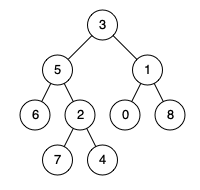给定一个二叉树, 找到该树中两个指定节点的最近公共祖先。
百度百科中最近公共祖先的定义为:“对于有根树 T 的两个结点 p、q,最近公共祖先表示为一个结点 x,满足 x 是 p、q 的祖先且 x 的深度尽可能大(一个节点也可以是它自己的祖先)。”
例如,给定如下二叉树: root = [3,5,1,6,2,0,8,null,null,7,4]

示例 1:
输入: root = [3,5,1,6,2,0,8,null,null,7,4], p = 5, q = 1 输出: 3 解释: 节点5和节点1的最近公共祖先是节点3。
示例 2:
输入: root = [3,5,1,6,2,0,8,null,null,7,4], p = 5, q = 4 输出: 5 解释: 节点5和节点4的最近公共祖先是节点5。因为根据定义最近公共祖先节点可以为节点本身。
说明:
- 所有节点的值都是唯一的。
- p、q 为不同节点且均存在于给定的二叉树中。
C#代码
/**
* Definition for a binary tree node.
* public class TreeNode {
* public int val;
* public TreeNode left;
* public TreeNode right;
* public TreeNode(int x) { val = x; }
* }
*/
public class Solution {
public TreeNode LowestCommonAncestor(TreeNode root, TreeNode p, TreeNode q)
{
/*递归边界*/
if (root == null) return null;
if(root.val == p.val || root.val == q.val) return root;
/*分别查找左右子树中的公共祖先*/
TreeNode left = LowestCommonAncestor(root.left, p, q);
TreeNode right = LowestCommonAncestor(root.right, p, q);
/*三种结果:左边为空但右边存在;左边存在但右边为空;左右均不存在。*/
if(left == null) return right;
if(right == null) return left;
return root;
}
}